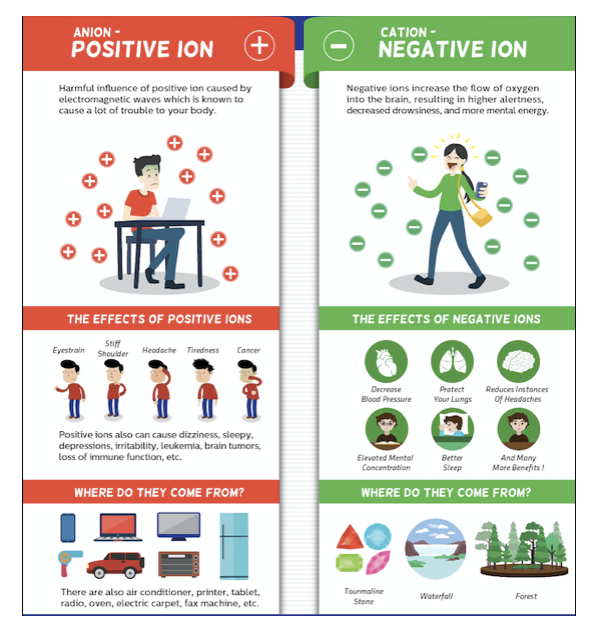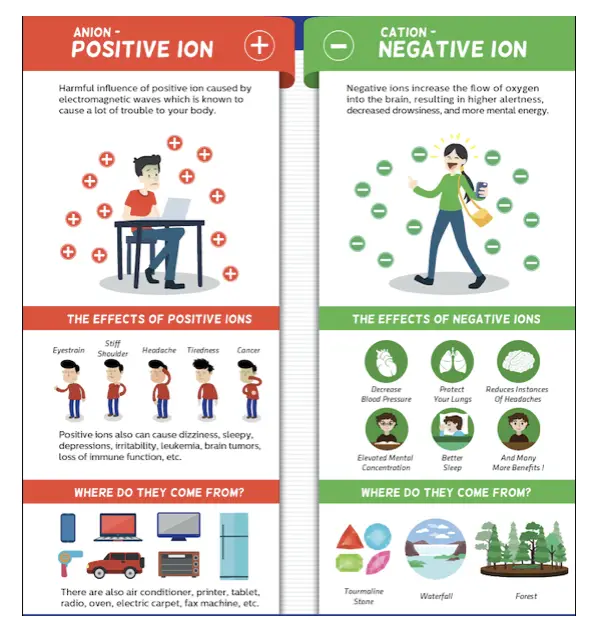Last Updated on 1 year by Francis
Whether you’re in a good mood or a bad one, the air we breathe can have a huge impact on our emotional state. This is because the air is filled with ions, which can either be positive or negative. So, do negative ions really make us happy? In this article, we take a look at the science behind negative ions and their potential to affect our happiness. We’ll discuss the theories behind why negative ions may make us happier, how they work and how we can harness their power to improve our emotional wellbeing.

Contents
What Are Negative Ions and How Do They Make You Feel?
Negative ions are particles found in the air that can have a positive effect on our wellbeing. They are produced by natural sources such as waterfalls, rain, forests, and the ocean, as well as by man-made sources such as air purifiers and ionizers. Negative ions help to balance the number of positive ions in the air, which are created by electronics such as computers, televisions, and cell phones. Negative ions have been linked to improved mood, increased energy, better concentration, and improved sleep.
The exact mechanism by which negative ions affect our mood and energy levels is still not completely understood, but research has shown that they can bind with serotonin – a neurotransmitter that is responsible for our mood and happiness – and thus may have a calming and uplifting effect. Negative ions have also been found to improve air quality by reducing airborne pollutants and allergens, which may also have a positive effect on our health and wellbeing.
Can Negative Ions Really Make You Happy?
There is some evidence to suggest that negative ions can have a positive effect on our mood and wellbeing, though more research is needed to fully understand the mechanism by which this occurs. A number of studies have shown that people who are exposed to negative ions for a period of time tend to report improved mood, increased energy, and better sleep. Additionally, negative ions have been found to reduce the levels of airborne pollutants and allergens, which can also have a positive effect on our health and wellbeing.
In one study, people who were exposed to negative ions for a period of two weeks reported feeling calmer and more relaxed than participants who were not exposed to negative ions. The same study also found that participants exposed to negative ions experienced improved cognitive performance and an increase in energy.
Another study found that people who were exposed to negative ions for a period of three hours reported feeling more alert and less fatigued than participants who were not exposed to negative ions. The study also found that people who were exposed to negative ions experienced a decrease in anxiety and depression symptoms.
What Are the Benefits of Negative Ion Therapy?
Negative ion therapy is a form of energy healing that involves the use of negative ions to balance the energy in the body and promote healing. Proponents of negative ion therapy believe that negative ions can help to reduce stress, relieve pain, and improve overall wellbeing.
The exact mechanism by which negative ion therapy works is still not fully understood, but research has shown that it can have a positive effect on our health and wellbeing. One study found that people who underwent negative ion therapy for four weeks reported improved sleep quality, increased energy, and improved mood. Additionally, the study found that people who underwent negative ion therapy experienced a decrease in symptoms of depression and anxiety.
Are There Any Risks Associated with Negative Ion Therapy?
Negative ion therapy is generally considered safe, but it is important to note that it is not regulated by the FDA and should be used with caution. Additionally, some people may experience mild side effects such as headache, dizziness, and nausea. If you experience any of these side effects, it is important to stop using the therapy and consult your doctor.
How Can You Get More Negative Ions?
The easiest way to get more negative ions is to spend time in nature, as natural sources such as waterfalls, rain, forests, and the ocean are rich in negative ions. Additionally, you can use an air purifier or ionizer to create more negative ions in your home. Finally, you can try negative ion therapy, though it is important to note that it is not regulated by the FDA and should be used with caution.
Related Faq
Q1: What are Negative Ions?
A1: Negative ions are particles in the air that have one extra electron, making them negatively charged. They are created through natural processes such as sunlight, waterfalls, and lightning, as well as through man-made processes such as air conditioners and electrical appliances. Negative ions are believed to have a positive effect on our overall health and wellbeing.
Q2: How Do Negative Ions Make You Happy?
A2: Negative ions are believed to improve our mood and reduce stress levels. This is because negative ions are thought to increase serotonin levels in the brain, which is a neurotransmitter that has a calming effect and helps to regulate mood. Negative ions have also been linked to improved breathing, increased energy levels, and improved concentration.
Q3: Where Can I Find Negative Ions?
A3: Negative ions can be found in nature, such as near waterfalls and the ocean. They can also be generated through man-made devices, such as air purifiers, humidifiers, and ionizers. Negative ions are also found in some types of salt lamps, which are lamps made from large pieces of salt that emit negative ions when heated.
Q4: Are Negative Ions Safe?
A4: Yes, negative ions are generally considered to be safe. They are naturally occurring particles found in the air, so there is no need to worry about any harmful side effects. However, it is important to note that some people may be more sensitive to them than others, so it is best to start with small amounts and see how your body responds.
Q5: How Can I Increase the Negative Ions in My Home?
A5: One way to increase the negative ions in your home is to use an air purifier or ionizer. These devices are designed to trap airborne particles, such as dust and allergens, and to emit negative ions. You can also use a salt lamp, which is a lamp made from large pieces of salt that emit negative ions when heated.
Q6: Are There Any Risks Associated With Negative Ions?
A6: While negative ions are believed to be generally safe, there are some potential risks associated with their use. It is possible that negative ions can cause dizziness, headaches, or nausea in some people, so it is important to monitor how your body responds when using them. Additionally, too many negative ions in a confined space can cause an imbalance, so it is important to use them in moderation.
Boost Your Mood With Negative Ions
In conclusion, the evidence is clear that negative ions do indeed make you happy. The natural abundance of negative ions in the air, particularly near waterfalls and oceans, is a key factor in the feelings of relaxation and joy that we experience when we are in these areas. Additionally, artificially generated negative ions can be used to improve mood in the home or workplace, helping us to feel more relaxed and content. Therefore, negative ions can indeed make us happy.








